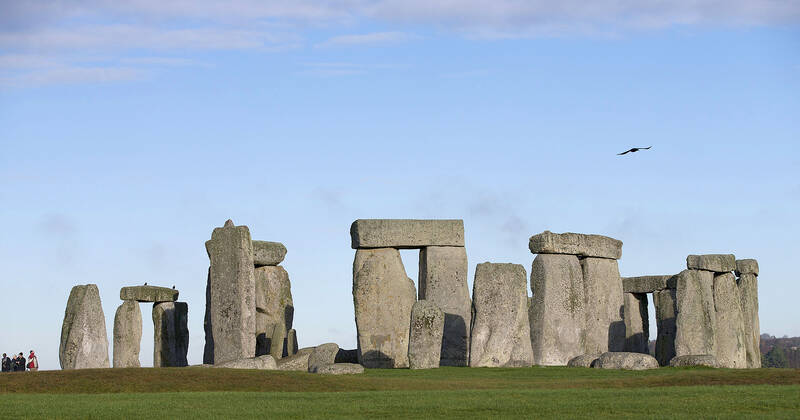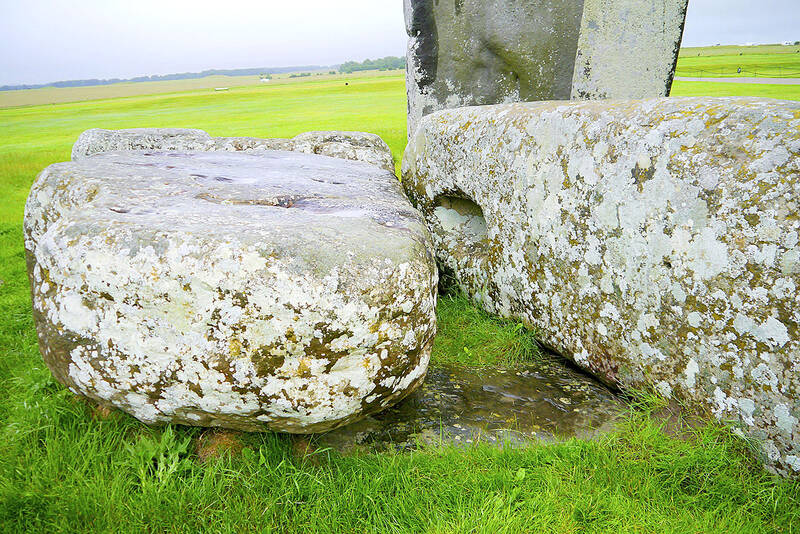For more than a century, archaeologists have known that some of the stones at Stonehenge came from Wales and were transported — somehow — about 200km to the site of the Neolithic monument on Salisbury Plain.
Now, a “jaw-dropping” study has revealed that one of Stonehenge’s central megaliths is not Welsh at all — it is actually Scottish.
In a discovery described by one of the scientists involved as “genuinely shocking,” new analysis has found that the largest “bluestone” at Stonehenge was dragged or floated to the site from the very north-east corner of Scotland — a distance of at least about 750km.

Photo: AP
The astonishing finding that the megalith, which is known as the “altar stone,” was transported by prehistoric people from at least as far as present day Inverness, and potentially from the Orkney islands, “doesn’t just alter what we think about Stonehenge, it alters what we think about the whole of the late Neolithic,” said Rob Ixer, an honorary senior research fellow at University College London (UCL) and one of the experts behind the study, which was published in Nature on Wednesday.
“It completely rewrites the relationships between the Neolithic populations of the whole of the British Isles,” he said. “The science is beautiful and it’s remarkable, and it’s going to be discussed for decades to come … It is jaw-dropping.”
The altar stone is not one of Stonehenge’s famous trilithons — the immense, lintel-topped sarsen stones, which originate from a mere 25km away, and which today form its outer circle. Instead, the huge sandstone block, 5 meters long and weighing 6 tonnes, lies flat and semi-buried at the heart of the monument, trapped under two fallen sarsens and barely visible to visitors.

Photo: AP
Made of a sedimentary rock called old red sandstone, the altar stone is classed as a non-local bluestone and was long thought to have been brought from somewhere in Wales, just as a separate group of Stonehenge’s bluestones are now known to have been quarried in the Preseli Hills in Pembrokeshire.
The altar stone was an outlier, however, and research in recent years led archaeologists, including Ixer, to question whether its origins were Welsh at all.
The new study, which involved experts from Curtin University in Perth, Australia; the University of Adelaide; Aberystwyth University; and UCL, aimed to find out more by examining the stone’s chemical composition and the age of minerals within it.
Taken together, these give a characteristic “age fingerprint” to the sandstone, said Nick Pearce, a professor of geography and earth sciences at Aberystwyth who is another of the report’s co-authors.
“With that age fingerprint, you can match it to the same sort of rocks around the UK — and the match for the age fingerprint was a dead ringer for the Orcadian Basin in north-east Scotland,” he said. “It was completely unexpected to us.”
The finding may be astonishing, but the science is not controversial, said Pearce. “It’s very, very well-established science. It’s not something that people can look at say: ‘Oh no, that can’t be right.’”
The odds of the stone coming from elsewhere are “fractions of a percent,” he said.
For many, the biggest question will be one not explored in detail in the scientific paper: how on earth did Stonehenge’s builders transport the giant stone from Scotland to Wiltshire?
“Given major overland barriers en route from north-east Scotland to Salisbury Plain, marine transport is one feasible option,” said the lead author, Anthony Clarke, of Curtin University.
But the archaeologist and writer Mike Pitts, who was not involved in the research but whose work on Neolithic monuments includes the book How to Build Stonehenge, said he believed it was more likely the stone was dragged overland than floated by sea.
“If you put a stone on a boat out to sea, not only do you risk losing the stone — but also nobody can see it,” he said.
Instead, a land journey, perhaps taking many years, would engage people en route, with the stone “becoming increasingly precious … as it travels south”, he added.
Impossible as it may seem today, an overland journey “was easily within the reach of Neolithic technology.”
“[The study] is exciting and it’s so significant,” Pitts said. “It’s long been known that the bluestones come from Wales, but this identifies links with a quite different part of Britain, and significantly more distant from Stonehenge. So it suggests that the site was known not just to people in the south, but over a much wider area — and that opens suggestions for the whole way we think about Neolithic Britain.”

The only geopolitical certainty is that massive change is coming. Three macro trends are only just starting to accelerate, forming a very disruptive background to an already unsettled future. One is that technological transformations exponentially more consequential and rapid than anything prior are in their infancy, and will play out like several simultaneous industrial revolutions. ROBOT REVOLUTION It is still early days, but impacts are starting to be felt. Just yesterday, this line appeared in an article: “To meet demands at Foxconn, factory planners are building physical AI-powered robotic factories with Omniverse and NVIDIA AI.” In other words, they used AI

Last month historian Stephen Wertheim of the Carnegie Endowment for International Peace published an opinion piece in the New York Times with suggestions for an “America First” foreign policy for Democratic presidential candidate Kamala Harris. Of course China and Taiwan received a mention. “Under presidents Trump and Biden,” Wertheim contends, “the world’s top two powers have descended into open rivalry, with tensions over Taiwan coming to the fore.” After complaining that Washington is militarizing the Taiwan issue, he argues that “In truth, Beijing has long proved willing to tolerate the island’s self-rule so long as Taiwan does not declare independence

Big changes are afoot in global politics, which that are having a big impact on the global order, look set to continue and have the potential to completely reshape it. In my previous column we examined the three macro megatrends impacting the entire planet: Technology, demographics and climate. Below are international trends that are social, political, geopolitical and economic. While there will be some impact on Taiwan from all four, it is likely the first two will be minor, but the second two will likely change the course of Taiwan’s history. The re-election of Donald Trump as president of the US

Nov. 25 to Dec. 1 The Dutch had a choice: join the indigenous Siraya of Sinkan Village (in today’s Tainan) on a headhunting mission or risk losing them as believers. Missionaries George Candidus and Robert Junius relayed their request to the Dutch governor, emphasizing that if they aided the Sinkan, the news would spread and more local inhabitants would be willing to embrace Christianity. Led by Nicolaes Couckebacker, chief factor of the trading post in Formosa, the party set out in December 1630 south toward the Makatao village of Tampsui (by today’s Gaoping River in Pingtung County), whose warriors had taken the